
Nova Scotia

Halifax
NO PART OF THE FOLLOWING
ARTICLE AND PHOTOGRAPHS
MAY BE REPRODUCED WITHOUT
PERMISSION FROM THE AUTHOR ©
After retiring from The Royal Navy, James Findlay who had likely partaken in the festivities at earlier events on McNab's Island, saw a business opportunity and purchased some property known as The Hugonin Estate, of which he had been the caretaker. He opened his own picnic area in 1882 with the same attractions as Woolnough's Pleasure Grounds, which had been operating since the mid 1850s.
By the early 1890s, Findlay's had a canteen, croquet and quoits areas, a dance pavilion, foot-race track. picnic tables, and swings. Buildings were fairly primitive, being built out of trees cut on the property. They had the appearance of a latter day summer camp. The dance pavilion was a simple hall with a vaulted roof and open-beam interior construction held in place by steel rods and turnbuckles. Numerous windows lined each side of the wide-planked walls, above which ads for various products were displayed. Entertainment was provided by a piano in one corner, but dance bands of the times would likely have played, as well. To compete further with Woolnough's, Findlay also added carnival games, and later, a steam-powered, C.W. Parker carousel.
The 1895 season saw a surge in business with the construction of Garrison Pier. Although only about 750 metres from Woolnough's, Findlay's became the more popular. Many military personnel would come and go to the fortifications on the island via this new pier. If heading to the north, they would reach Findlay's before getting to Woolnough's, while Findlay's was already closest to those on the south end of the island. Many school and church groups booked their outings at this park with the men often going to the local forts where beer was only 5 cents for about the equivalent of today's 590 millilitre soft drink bottles.
|
Carousel 19-0s or 1910s 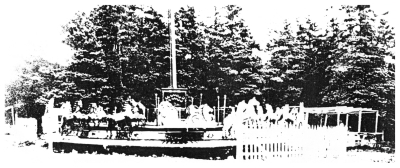
(NSAR Photo #1992-366.26) In this overexposed photo, the carousel sits out in the open. In the center is a band organ music source, while to the left is what appears to be part of the power unit. |
The carousel that was put in was a simple affair which had a substantial home-made look to it. It was actually a portable C. W. Parker "Carry-Us-All" model that consisted of a central pole supporting a turntable platform about 15 metres in diameter. Underneath its perimeter was a circular track upon which a series of wheels ran. Their axels supported the outer edge of the turntable which had on top two rows of horses and four chariots around the perimeter. The platform was not solid for its entire circumference, but had board slats with narrow gaps, or no gaps where one might stand or rest one's feet. Under the horses and chariots these gaps became wider in places. These can be seen in the accompanying photos. There was no covering until a roof was built over the ride some season after its first.
The platform upon which the horses and chariots were attached was on sweeps coming from the center and extending out under each row of horses and under each chariot. (Most carousels have the sweeps overhead with the horses supported via drop rods.) The mounting here was strap iron under each horse and chariot that extended below to attach to the platform. Decoration was on the sides of each chariot and on a small rounding board on the the platform just inside and below the inner row of horses. Since there were no cranking rod mechanisms, none of the steeds were jumpers. However, this Parker model did typically incorporate a rocking mechanism to simulate a galloping motion. Total horses appear to be 24, with four, 2-seat chariots. This would make it the largest "Carry-Us-All" model from the Parker catalog of the time. Rides were 10 cents.
|
Carousel 19-0s or 1910s 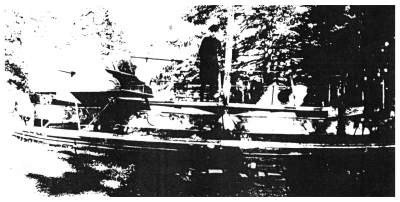
(NSAR Photo #1992-366.46) Might this be a young Bill Lynch? (See farther on.) |
Near the center of the platform and facing the entrance side of the ride was its music source. It was a band organ, which was a mechanical device that played musical instruments attached to mechanical arms and bellows. However, there seem to be no visible percussion instruments on this one. As such, it could be a calliope (kal-LIE-oh-pee), a steam-driven organ. This is possible since the power source was a steam engine.
If the music source was a calliope, a steam pipe would have to have been run in the raceway to power the unit. Otherwise, it would have to be connected to the belt system and have some sort of bellows to force air through the pipes. However, if it was a band organ, it still could have had percussion instruments included such as drums and bells, but hidden inside. In the photos though, this does appear to be a typical band organ offered by the Parker company.
|
Carousel Music Source 19-0s or 1910s 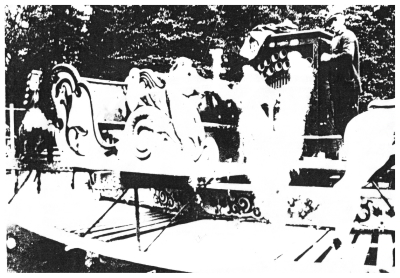
(NSAR Photo #1992-366.64) The music source is seen in this closer view. Note the support strapping for the chariots and horses. |
The power source was separated some distance away to the left of the front of the ride. It consisted of a firebox/boiler and power take-off. This steam unit was built as a portable "wagon" supported at the sides of the firebox and boiler by two large wheels a metre or more in diameter. At the front was a trailer hitch with two smaller wheels for transit purposes. These smaller ones can just be discerned in the photograph.
|
Carousel Power Source 19-0s or 1910s 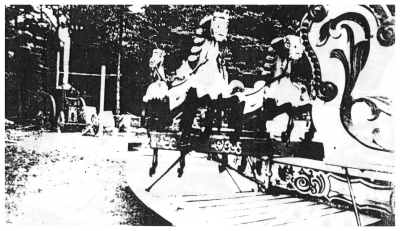
(NSAR Photo #1992-366.44) A better view of the power source at the left shows that it's a steam engine. It had a belt mechanical take-off used to rotate the ride. Steam power was an option offered in the Parker catalogue of the era. |

To your right is a photo of a portable steam engine sold by the Parker Company as currently displayed by the Dickinson County Historical Society in Abilene, Kansas. This (or very similar) appears to be the model that was at Findlay's. It shows the firebox/boiler and power take-off arrangement along with the trailer setup, minus the hitch. At the park a belt wrapped around a flywheel and went through a covered wooden raceway along the ground to underneath the ride platform. Since there were two flywheels, each may have had its own belt. Near the ride end of the raceway was a box supported by two guy rods one each running to the ground on either side of the perimeter of the ride. Later models had the flywheel drive an electric generator. This powered an electric motor that in turn rotated the platform.
For at least one season there was a short picket fence that only ran about 1/8th of the perimeter of the platform near the front-right side of the ride. It ended near what appears to have been some booths. These booths likely had games, as both the ride and games were operated by the same owner. In a later season, the ride was covered with a roof that had fence rails between the support posts to protect spectators from the rotating platform.
It is not known what year the carousel went into Findlay's, but it would likely have been sometime between 1898 (the year of the first "Carry-Us-All") and 1910, after which the park ran into troubles, as described shortly. I suspect the 19-0s as being the most likely time -- perhaps after the park changed owners. A clue that this is the correct time period can be had by noticing that the horses do not have outstreached limbs. This latter style of carving by the Parker Company was not introduced until sometime after its move to new premises in 1911.
Carousel researcher Patrick Wentzel has contributed some information: "The carousel may have been an Armitage-Hershell track (steam-powered) machine built in North Tonawanda, New York around 1895 to 1900. It does have a band organ, not a calliope, which would have been driven by a belt from the carousel mechanism." However, CEC research into Parker carousels has found photos matching that company's "Carry-Us-Alls", and thus it is concluded to be a Parker model. Patrick may yet be correct, though, because the Parker company closely copied A-H horses at that time.
Parker "Carry-Us-All"
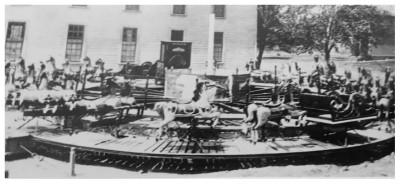
Here is a photo taken around 1902. It shows a "Carry-Us-All" model set up. Although the band organ is different, notice this ride's similarity to the Findlay carousel. |

After the 1905-1906 British Military pull-out of Halifax, business dropped on McNab's, but James Findlay was able to hang on and he even eventually bought out his competition Woolnough's Pleasure Grounds. An advantage Findlay's had over competitors, besides its superior location between the dock and some of the forts, was that an A.J. Davis soft drink called "Pure McNab" was made and bottled right at Findlay's Grounds. It would be Davis who would gain control of the Findlay operation shortly after its purchase of Woolnough's. Davis had built a summer home on the Woolnough property. That home, known today as The Conrad House, may still be visited.
Despite the soft drink draw, business declined in later years to the point where the bottling plant ceased operations sometime between 1912 and 1915, further depriving the remaining patrons. Two factors that contributed to this decline were The Temperance Act of 1910 which eliminated the sale of alcohol on Sunday, and a religious group which had successfully stopped ferry service on Sundays. Of course for many, one of the few days available for recreation was Sunday and this decree made the island accessible only by private boat on that day. Business suffered again after the start of The Great War in 1914 because the island was restricted to military personnel as a security precaution.
Another thing which would have been a factor in reduced numbers for the 1918 and possibly 1919 seasons was The Halifax Explosion. Two ships collided in a narrow channel of Halifax Harbour on December 6th, 1917. One, Mont Blanc, was a munitions ship bound for the war in Europe. It collided with the Belgium Relief ship Imo (Ee-moh). The resulting fire caused an explosion which is considered to be the largest accidental, man-made one up until the first atomic bomb was set off at the Trinity Test Site near Alamagordo in July of 1945. Most of Halifax and Dartmouth were destroyed or heavily damaged, and at least 2,000 people were killed directly, or in the resulting fires, or by hypothermia from the cold weather and snowstorm which blanketed the area on the next day. 9,000 more were injured to one degree or another.
Some sources list fewer deaths, but a 2002 committee commissioned by the Halifax Foundation determined that it was just under 2,000. It may have actually been as high as 3,000 based on the number of coffins made at the time, but with so many transients in the city because of the World War and the fact that people simply vanished with no trace, the true number will never be known.
A covering of snow fell a day after the disaster, hampering
rescue efforts and killing some trapped survivors due to
hypothermia. These photos were taken after that snowfall.
(City of Toronto Archives: James Collection)
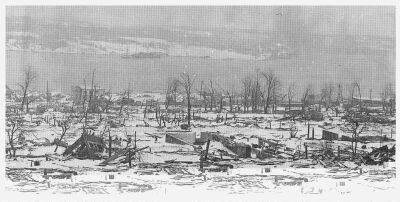 |
Halifax Explosion Ground Zero 1917 |
|
This view, facing east, looks past a Halifax-side
residential community's remains toward the harbour
"narrows". The explosion happened near the docks,
just out of frame to the left, after Mont Blanc
drifted to the Halifax side following the collision. The destruction is total and is reminiscent of the remains of Hiroshima and Nagasaki, as would befall those cities almost three decades later. Here, streets may be seen, but the wooden houses have been blown away to the point where not even substantial debris is left. The solitary structures seen close to the water were industries that were made of brick or concrete. Still, only shells stand. Dartmouth is in the background where the Imo, may be seen beached at Top Center. |
|
Halifax Explosion Waterfront 1917 |
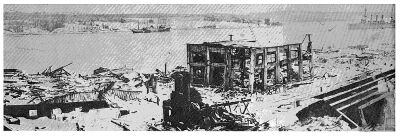 (MacLaughlin Photo) |
| This scene of the waterfront was taken facing south east and left of the above. It is also nearer to the harbour. The Imo is seen in both shots aground on the Dartmouth shore. |
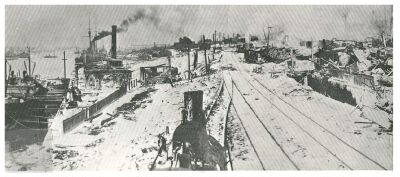 (MacLaughlin Photo) |
Halifax Explosion Rail Yards and Waterfront 1917 |
|
This is to the right of the above, looking south.
It was taken from the top of the foreground
locomotive or its tender and looks along the rail
yards to what had been industries along the
waterfront. The ship at far Center Left is in a
graving (dry) dock. Some of the vessels seen in
the harbour would have been bringing aid to the
stricken city. McNab's Island lies in the far background out of sight behind the sailing ship at Top Left. |
Although the island was far enough away at the mouth of the harbour to not suffer any serious damage, patronship for the 1918 season surely must have been diminished. This was because so many in the city had lost family members or had neighbours and friends that did. 6,000 were homeless, and 25,000 others had inadequate shelter. Most of 1918 had what military could be spared from the war being involved in the rebuilding of the city and helping people pick up what was left of their lives - not spending time at an amusement park. Another factor was likely the influenza pandemic of 1918/19 which saw illness and more deaths - again, not a time when people are going to go to recreation areas.
After the war, the grounds continued to operate but Davis sold his interest to Bill Lynch, whose father, Matthew, was a lighthouse keeper on the island. Bill had worked at a games concession and operated the carousel at Findlay's during his early teens. An exact year of the sale is unknown, but by the early 1920s, he was providing midways for local Nova Scotia events, so it's likely he had the money to make such a purchase by then. However, declining business saw Lynch remove the ride(*) and games from the island in 1925, to include in The Bill Lynch Carnival Company, a business he had formed with a partner, Ray Rogers, an entertainment concession provider. This later became Bill Lynch Shows after the partnership dissolved. It's unclear if this company was the one providing midways elsewhere, or if it was formed upon leaving Findlay's.
Regardless, the travelling carnival grew into Atlantic Canada's largest, and eventually the world's second largest (after Conklin) by the late 1950s. It provided midways for the area's major exhibitions. Bill died in 1972, but his family kept on until a car accident in 1995 killed two of the principals which eventually caused the company to be divided and sold. However, the primary part remains the leading carnival operation in the Atlantic area today. The present owner is John T. Drummey, who was the controller for Lynch Shows during the 1980s and 90s. Its new name is Maritime Rides and Attractions. Another part of the Lynch Shows has become Carnival Time Amusements. Both remain based in Nova Scotia.
By 1928 The Dartmouth Ferry Commission cancelled runs to McNab's, and Findlay's ceased to exist, except that Lynch would keep his ponies there during the off-season. Only private picnics occurred after that via small boat companies, except during World War II when the military exercised control once again.
Since the 1970s, the island has come under public control after a regional parks plan suggested that McNab's be part of it. In 1983, The Province of Nova Scotia assumed responsibility for forming the park and has since been buying up private properties. With that and the handing over of military properties to Parks Canada, 99% of the island is now public owned, either federally or provincially. Today, although there are no amusements there, the island is once again open to the public for sight-seeing, fort exploring, picnicking, swimming, and hiking. Several ferry services schedule regular runs in the summertime, with service available in winter by request.
(*) The steam-powered carousel was apparently used by Lynch Shows until gasoline and/or electric power became more practical. The unit was then stored somewhere in the Halifax area for decades in a disassembled state until sold piecemeal to collectors in the 1970s or 80s.
|
Thanks to Jeff Parsons of Dartmouth, Nova Scotia for
suggesting this park.
For more on McNab's Island itself, see:
|
Return to the
Closed Canadian Parks Index
